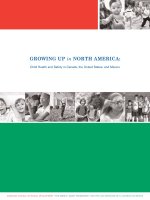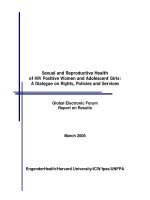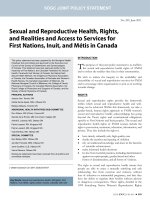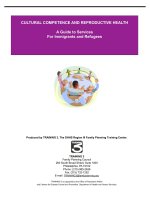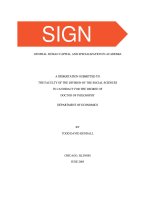Sexual and Reproductive Health, Rights, and Realities and Access to Services for First Nations, Inuit, and Métis in Canada docx
Bạn đang xem bản rút gọn của tài liệu. Xem và tải ngay bản đầy đủ của tài liệu tại đây (166.95 KB, 5 trang )
SOGC JOINT POLICY STATEMENT
JUNE JOGC JUIN 2011 l 633
Sexual and Reproductive Health, Rights,
and Realities and Access to Services for
First Nations, Inuit, and Métis in Canada
No. 259, June 2011
This policy statement has been prepared by the Aboriginal Health
Initiatives Sub-Committee and approved by the Executive and
Council of the Society of Obstetricians and Gynaecologists
of Canada This statement was also approved jointly by the
Assembly of First Nations, the Canadian Federation for Sexual
Health, Pauktuutit Inuit Women of Canada, the NativeYouth
Sexual Health Network, the Indigenous Physicians Association
of Canada, the Canadian Association of Perinatal and Women’s
Health Nurses, the Canadian Association of Midwives, the
National Aboriginal Council of Midwives, the College of Family
Physicians of Canada, the Canadian Medical Association, the
Royal College of Physicians and Surgeons of Canada, and the
Society of Rural Physicians of Canada
PRINCIPAL AUTHORS
Jessica Yee, Toronto ON
Alisha Nicole Apale, MSc, Ottawa ON
Melissa Deleary, Toronto ON
ABORIGINAL HEALTH INITIATIVES SUB-COMMITTEE
Don Wilson, MD (Chair), Comox BC
Sandra de la Ronde, MD (Co-Chair), Calgary AB
André B Lalonde, MD, Ottawa ON
Paula Lessard, RN, Kingsport NS
Pierre Lessard, MD, Kingsport NS
Vyta Senikas, MD, Ottawa ON
SPECIAL COMMITTEE
Geri Bailey, BSN, Ottawa ON
Jennifer Ferrante, BEd, Ottawa ON
Jane Gauthier, LLB, Ottawa ON
Verna Stevens, Ottawa ON
Disclosure statements have been received from all authors and
committee members
Key Words: Sexual and reproductive health, Aboriginal, First
Nations, Inuit, Métis, rights, justice, access, culturally safe care
INTRODUCTION
T
he purpose of this joint policy statement is to reafrm
the sexual and reproductive health rights of FNIM
and to reect the realities they face in their communities.
We wish to reduce the inequity in the availability and
accessibility of sexual and reproductive services for FNIM
and to encourage other organizations to join us in working
towards change.
RIGHTS
Sexual and reproductive rights provide the framework
within which sexual and reproductive health and well-
being can be achieved. Within this framework, we take a
gender-based, human rights approach to FNIM women’s
sexual and reproductive health, acknowledging but going
beyond the Treaty rights and constitutional obligations
specic to First Nations and Inuit peoples. The sexual and
reproductive health rights of FNIM women include the
right to prevention, treatment, education, information, and
privacy. They also include the right to:
• have timely, culturally safe, high-quality care
• decide the number and spacing of children
• rely on traditional knowledge and share in the benets
of scientic advancement
• make informed health decisions
• be free from harmful practices, including discrimination
against two-spirit people, gender-based and other
forms of discrimination, and all forms of violence.
The right to sexual and reproductive health means that
people are able to enjoy a mutually satisfying and safe
relationship, free from coercion and violence, without
fear of infection or unintended pregnancy, and that they
have the ability to regulate their fertility without adverse
or dangerous consequences. These rights, detailed in the
1999 SisterSong Native Women’s Reproductive Rights
J Obstet Gynaecol Can 2011;33(6):633-637
634 l JUNE JOGC JUIN 2011
SOGC JOINT POLICY STATEMENT
and Health Roundtable
1
and codied in the 2007 United
Nations Declaration on the Rights of Indigenous Peoples
(Appendix 1),
2
must be protected and promoted at the
national and the international level by communities, health
organizations, and individuals.
REALITIES
Protecting and promoting the sexual and reproductive
health rights of FNIM requires awareness of the barriers
to health and well-being, such as access to culturally safe
services, as well as a clear understanding of the needs and
interests of FNIM and related policies and practices.
FNIM women experience a disproportionately high rate
of sexually transmitted infections, reproductive tract
infections, high-risk pregnancies, complicated and pre-
term deliveries, maternal mortality, teenage pregnancies,
and sexual violence.
3
FNIM women are more likely than
the general population to have low- and high-birthweight
babies and babies born with fetal alcohol spectrum disorder
and other developmental disorders.
4
Among First Nations
and Inuit, the infant mortality rate is 2 to 4 times higher
than it is in the general population.
5
FNIM women also
experience higher than average rates of obesity, diabetes,
postpartum depression, and cervical cancer.
3
FNIM women
are more likely to live in communities characterized by
disadvantageous socioeconomic conditions, including low
educational attainment, limited employment opportunities,
poverty, food insecurity and subsequent poor nutrition,
overcrowded and/or substandard housing, smoking and
substance abuse, family and community disintegration,
and political marginalization.
6
Additionally, the degradation
and contamination of FNIM lands, air, and water not only
directly damages FNIM women’s sexual and reproductive
health but also presents known and unknown health risks
to their children and their children’s children.
7
It is widely recognized that poor health outcomes among
FNIM are exacerbated by inadequate access to health and
social services that results from historical and ongoing
forms of colonization, including structural barriers,
racist and oppressive policies, restrictive NIHB policies
(Appendix 2), and complex social determinants of
health.
8–10
In both urban and rural areas, FNIM women
experience reduced access to health care services, as well
as poor access to culturally safe care.
4,11
Within maternity
services, human resources are in a particular, state of crisis.
There is a lack of accessible, culturally safe services, and
efforts to return low-risk births to the community are
intended to respond to this gap. These efforts must be part
of an integrated federal-provincial-territorial strategy.
12
Additionally, in rural and remote communities, it is often
difcult for women to maintain privacy when seeking
health services, and to access and obtain coverage for
core reproductive health therapeutics, such as (emergency)
contraception, counselling, and support. This may be
particularly challenging for young women and teenagers in
rural areas, who may lack awareness about their sexual and
reproductive health and health rights and choices, which
include abortion, and who may have fewer care options
than some of their urban counterparts. Forty-eight percent
of FNIM are under the age of 25.
13
With a high teen
pregnancy rate and associated risk of early school drop-out
and unemployment, the need for empowering policies and
programs that engage youth is urgent.
These realities underlie the need for comprehensive,
coordinated policies and practices that promote and
protect the right of every person to sexual and reproductive
health and well-being. Similarly, there is a need to advance
the cultural competence of health service providers to
ensure the delivery of culturally safe services. This includes
increasing awareness of First Nations and Inuit specic
programs such as the NIHB as a means of ensuring and
advocating equity in the coverage of health benets for
First Nations and Inuit (Appendix 2). It also includes
promoting initiatives already underway that work to restore
reproductive justice, ght homophobia and transphobia,
and support people with disabilities.
RECOMMENDATIONS
As part of our efforts to promote sexual and reproductive
health and well-being among First Nations, Inuit, and
Métis, we recommend the following.
1. Advocate awareness of and commitment to the
protection and promotion of the sexual and
reproductive health rights of FNIM by health care
providers, organizations, and political and community
leaders across Canada.
2. Advise the Government of Canada to act on
and implement the recommendations of the UN
Declaration on the Rights of Indigenous Peoples,
2
specically Articles 23, 24.1, and 24.2 (Appendix 1).
3. Develop cultural competence among health care
providers, so that care is offered in a culturally safe
ABBREVIATIONS
FNIM First Nations, Inuit, and Métis
NIHB Non-Insured Health Benets
JUNE JOGC JUIN 2011 l 635
Sexual and Reproductive Health, Rights, and Realities and Access to Services for First Nations, Inuit, and Métis in Canada
way and tailored to the specic needs and interests
of FNIM. This should take into account the social
determinants of health and clinical, structural, and
policy-level barriers to care.
4. Support the development of a federal-provincial-
territorial Aboriginal birthing strategy to address the
crisis in FNIM maternal health care in a systematic way.
5. Promote awareness and understanding of Non-
Insured Health Benets for First Nations and Inuit
among health care providers. This includes the process
of obtaining coverage for over-the-counter drugs and
drugs that require special NIHB approval.
6. Promote changes to NIHB policies to increase access
to emergency and alternative contraceptives,
counselling on sexual and mental health, and
midwifery, and to encourage a return of traditional
birthing to communities.
REFERENCES
1. The Native American Women’s Health Education Resource Centre.
SisterSong Native Women’s Reproductive Rights and Health Roundtable
Convenes. Available at: Accessed
January 20, 2010.
2. United Nations. Declaration on the rights of indigenous peoples.
Adopted by General Assembly Resolution 61/295 on 13 September 2007.
New York: United Nations; 2007. Available at: />socdev/unpi/en/drip.html. Accessed April 6, 2011.
3. Stout M D, Kipling GD, Stout R. Aboriginal women’s health research
synthesis project nal report. Centres of Excellence for Women’s
Health; 2001. Available at: />synthesisEN.pdf. Accessed October 26, 2010.
4. Wassimi S, Wilkins R, Mchugh N, Xiao, L, Simonet F, Luo Z-C.
Association of macrosomia with perinatal and postneonatal mortality
among First Nations people in Quebec. CMAJ February 22, 2011;183(3).
First published January 17, 2011. doi :10.1503/cmaj.100837.
5. Luo Z-C, Wilkins R, Heaman M. Birth outcomes and infant mortality by
the degree of rural isolation among First Nations and non-First Nations in
Manitoba, Canada. J Rural Health 2010;26(2):175–81.
6. Adelson N. The embodiment of inequity: health disparities in aboriginal
Canada. Can J Public Health 2005;96(Suppl 2):S45–61.
7. INCITE! Women of Colour Against Violence. International indigenous
women’s environmental and reproductive health symposium declaration.
August 19, 2010. Available at:
/>womens-environmental-and-reproductive-health-symposium-declaration/.
Accessed January 21, 2010.
8. Geyor-Dyke E. Poverty and chronic disease: recommendations for
action. Chronic Disease Prevention Alliance of Canada; April 2008.
9. First Nations Centre. First Nations regional longitudinal health survey
(RHS) 2002/2003: results for adults, youth and children living in First
Nations communities. Ottawa: First Nations Centre at the National
Aboriginal Health Organization; 2005.
10. Assembly of First Nations. First Nations action plan for Non-Insured
Health Benets. Ottawa: Assembly of First Nations; April 25, 2005.
Available at: http://64.26.129.156/cmslib/general/NIHB%20Action%
20Plan_Fe.pdf. Accessed February 16, 2011.
11. Urban Indian Health Institute, Seattle Indian Health Board. Reproductive
health of urban American Indian and Alaska Native women: examining
unintended pregnancy, contraception, sexual history and behavior, and
non-voluntary sexual intercourse. Seattle: Urban Indian Health Institute;
2010.
12. Lalonde AB, Butt C, Bucio A. Maternal health in Canadian Aboriginal
communities: challenges and opportunities. J Obstet Gynaecol Can
2009;31:956–62.
13. Indian and Northern Affairs Canada. Fact Sheet: 2006 Census Aboriginal
Demographics. Indian and Northern Affairs Canada. Available at:
Accessed October 26, 2010.
14. Two Spirit Society of Denver. What does two spirit mean? [web page].
Available at: . Accessed February 9, 2011.
15. Shen E. Asian Communities for Reproductive Justice answers the
question: what is reproductive justice. Collective Voices 2005 Spring;1(2):6.
636 l JUNE JOGC JUIN 2011
SOGC JOINT POLICY STATEMENT
APPENDIX 1. UNITED NATIONS DECLARATION ON THE RIGHTS OF INDIGENOUS PEOPLES
Article 23
Indigenous peoples have the right to determine and develop priorities and strategies for exercising their right to
development. In particular, indigenous peoples have the right to be actively involved in developing and determining health,
housing and other economic and social programmes affecting them and, as far as possible, to administer such programmes
through their own institutions.
Article 24
1. Indigenous peoples have the right to their traditional medicines and to maintain their health practices, including the
conservation of their vital medicinal plants, animals and minerals. Indigenous individuals also have the right to access,
without any discrimination, to all social and health services.
2. Indigenous individuals have an equal right to the enjoyment of the highest attainable standard of physical and mental
health. States shall take the necessary steps with a view to achieving progressively the full realization of this right.
APPENDIX 2. NON-INSURED HEALTH BENEFITS
Restrictive eligibility criteria, excessive paperwork requirements surrounding predetermination clauses, and the high
rejection rate for certain therapeutics have a signicant impact on the quality and timeliness of services and may result in
prolonged illness, increased program costs, and a violation of Treaty rights.
NIHB benets and policies are specically available to First Nations and Inuit women as per Treaty rights and constitutional
obligations. Our use of “First Nations” and “Inuit” here is in keeping with the eligibility criteria of these policies.
JUNE JOGC JUIN 2011 l 637
Sexual and Reproductive Health, Rights, and Realities and Access to Services for First Nations, Inuit, and Métis in Canada
APPENDIX 3. DEFINITIONS
Aboriginal Peoples
“Aboriginal” is an umbrella term that refers to all groups of Canada’s indigenous people: First Nations, Inuit, Métis, status
and non-status. In this document, the term “Aboriginal Peoples” is used inclusively.
Culturally Safe Care
Culturally safe care refers to the integration and transformation of knowledge about individuals and groups of people into
specic standards of care, policies, and practices. It refers to care that is adapted to the particular sociocultural context of
FNIM, including awareness of unique needs, interests, health beliefs, and behaviours.
Culturally Competent Care
Culturally competent care is care that demonstrates a commitment to engage in dialogue and relationship building with
FNIM communities. This commitment is primarily aimed at improving health through increased personal and professional
development and awareness of FNIM cultures and health practices.
Non-Insured Health Benets (NIHB)
The NIHB provides coverage for eligible First Nations and Inuit people residing in Canada. The program provides
benets that are not covered under hospital, provincial, or territorial health care: eye and vision care, dental care, medical
transportation, drugs/pharmaceuticals, medical supplies and equipment, crisis counselling, and approved health service
outside Canada. In this document, reference to NIHB refers specically to benets for First Nations and Inuit
Two Spirit
The Two Spirit Society of Denver
14
provides the following denition:
The term Two Spirit is a modern universal phrase that can be applied to Native Americans who are Gay, Bisexual,
Lesbian, or Transgendered (GBLT). Use of the term Two Spirit carries with it the general inference of respect to the
traditional role that a GBLT individual would have played among their people(s) prior to colonization. While it is most
correct to use a people’s individual term for their GBLT members, the term Two Spirit is useful when referring to
Native American GBLT groups comprised of members from different or multiple Native peoples.
Reproductive Justice
Eveline Shen
15
denes reproductive justice as
The complete physical, mental, spiritual, political, economic, and social well-being of women and girls . . . [and] . . .
will be achieved when women and girls have the economic, social and political power and resources to make healthy
decisions about our bodies, sexuality and reproduction for ourselves, our families and our communities in all areas of
our lives.
Homophobia
Homophobia is a collection of violent messages, beliefs and actions that disrespect, degrade, marginalize, discount, and
make invisible non-heterosexual people. (Lesbian, Gay, Bi, Trans Youthline. Email communication, April 6, 2011.)
Transphobia
Transphobia is a collection of violent messages, beliefs, and actions that disrespect, degrade, marginalize, discount, and
make invisible people whose gender presentation/identity is not seen as congruent with the sex they were assigned at
birth. (Lesbian, Gay, Bi, Trans Youthline. Email communication, April 6, 2011.)
